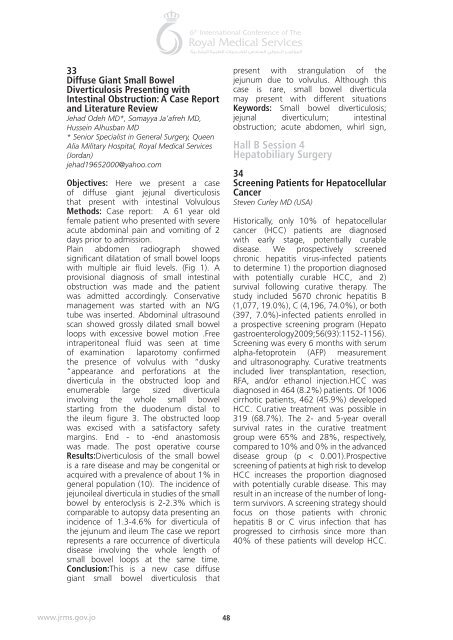Abstract book 6th RMS 16.indd
Abstract book 6th RMS 16.indd
Abstract book 6th RMS 16.indd
You also want an ePaper? Increase the reach of your titles
YUMPU automatically turns print PDFs into web optimized ePapers that Google loves.
33<br />
Diffuse Giant Small Bowel<br />
Diverticulosis Presenting with<br />
Intestinal Obstruction: A Case Report<br />
and Literature Review<br />
Jehad Odeh MD*, Somayya Ja’afreh MD,<br />
Hussein Alhusban MD<br />
* Senior Specialist in General Surgery, Queen<br />
Alia Military Hospital, Royal Medical Services<br />
(Jordan)<br />
jehad19652000@yahoo.com<br />
Objectives: Here we present a case<br />
of diffuse giant jejunal diverticulosis<br />
that present with intestinal Volvulous<br />
Methods: Case report: A 61 year old<br />
female patient who presented with severe<br />
acute abdominal pain and vomiting of 2<br />
days prior to admission.<br />
Plain abdomen radiograph showed<br />
significant dilatation of small bowel loops<br />
with multiple air fluid levels. (Fig 1). A<br />
provisional diagnosis of small intestinal<br />
obstruction was made and the patient<br />
was admitted accordingly. Conservative<br />
management was started with an N/G<br />
tube was inserted. Abdominal ultrasound<br />
scan showed grossly dilated small bowel<br />
loops with excessive bowel motion .Free<br />
intraperitoneal fluid was seen at time<br />
of examination laparotomy confirmed<br />
the presence of volvulus with “dusky<br />
“appearance and perforations at the<br />
diverticula in the obstructed loop and<br />
enumerable large sized diverticula<br />
involving the whole small bowel<br />
starting from the duodenum distal to<br />
the ileum figure 3. The obstructed loop<br />
was excised with a satisfactory safety<br />
margins. End - to -end anastomosis<br />
was made. The post operative course<br />
Results:Diverticulosis of the small bowel<br />
is a rare disease and may be congenital or<br />
acquired with a prevalence of about 1% in<br />
general population (10). The incidence of<br />
jejunoileal diverticula in studies of the small<br />
bowel by enteroclysis is 2-2.3% which is<br />
comparable to autopsy data presenting an<br />
incidence of 1.3-4.6% for diverticula of<br />
the jejunum and ileum The case we report<br />
represents a rare occurrence of diverticula<br />
disease involving the whole length of<br />
small bowel loops at the same time.<br />
Conclusion:This is a new case diffuse<br />
giant small bowel diverticulosis that<br />
present with strangulation of the<br />
jejunum due to volvulus. Although this<br />
case is rare, small bowel diverticula<br />
may present with different situations<br />
Keywords: Small bowel diverticulosis;<br />
jejunal diverticulum; intestinal<br />
obstruction; acute abdomen, whirl sign,<br />
Hall B Session 4<br />
Hepatobiliary Surgery<br />
34<br />
Screening Patients for Hepatocellular<br />
Cancer<br />
Steven Curley MD (USA)<br />
Historically, only 10% of hepatocellular<br />
cancer (HCC) patients are diagnosed<br />
with early stage, potentially curable<br />
disease. We prospectively screened<br />
chronic hepatitis virus-infected patients<br />
to determine 1) the proportion diagnosed<br />
with potentially curable HCC, and 2)<br />
survival following curative therapy. The<br />
study included 5670 chronic hepatitis B<br />
(1,077, 19.0%), C (4,196, 74.0%), or both<br />
(397, 7.0%)-infected patients enrolled in<br />
a prospective screening program (Hepato<br />
gastroenterology2009;56(93):1152-1156).<br />
Screening was every 6 months with serum<br />
alpha-fetoprotein (AFP) measurement<br />
and ultrasonography. Curative treatments<br />
included liver transplantation, resection,<br />
RFA, and/or ethanol injection.HCC was<br />
diagnosed in 464 (8.2%) patients. Of 1006<br />
cirrhotic patients, 462 (45.9%) developed<br />
HCC. Curative treatment was possible in<br />
319 (68.7%). The 2- and 5-year overall<br />
survival rates in the curative treatment<br />
group were 65% and 28%, respectively,<br />
compared to 10% and 0% in the advanced<br />
disease group (p < 0.001).Prospective<br />
screening of patients at high risk to develop<br />
HCC increases the proportion diagnosed<br />
with potentially curable disease. This may<br />
result in an increase of the number of longterm<br />
survivors. A screening strategy should<br />
focus on those patients with chronic<br />
hepatitis B or C virus infection that has<br />
progressed to cirrhosis since more than<br />
40% of these patients will develop HCC.<br />
www.jrms.gov.jo<br />
48

















